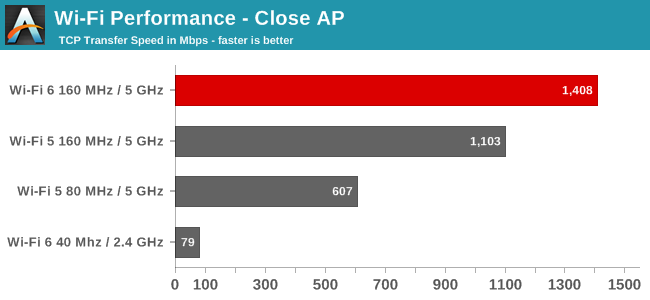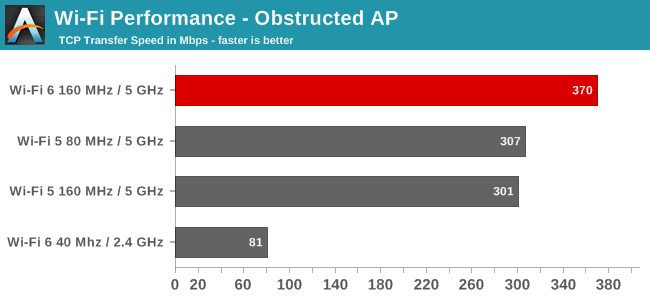AT 101: Wi-Fi 6 And Why You Want It
by Brett Howse on February 12, 2020 8:00 AM ESTPerformance
In order to achieve maximum performance, the latest Wi-Fi 6 standard leverages 1024-level QAM, but depending on the signal strength and quality it will scale down as needed, so to achieve the best performance very high signal to noise ratios are going to be required. Since 5 GHz is attenuated dramatically when it has to go through walls, if you need maximum Wi-Fi performance be aware that you are going to want your wireless router as close to the end device as possible. Luckily that is not an issue in our case, since the router is in the same room when testing for maximum performance, but we’ll also evaluate it in less than ideal scenarios as well.
Wi-Fi 5 vs Wi-Fi 6 – Close AP
First up we’ll test the TCP performance when the Access Point is in the same room as the client.

The performance advantages of Wi-Fi 6 are clear. With the access point in the same room, the SNR is very good and the new 802.11ax standard can really shine. With 1024 QAM and 160 MHz channels, the performance is over twice as fast as the outgoing Wi-Fi 5 with 256 QAM and 80 MHz channels. It is very impressive to see a typical 2x2:2 connection well over the Gigabit barrier, and even though the AX200 network card is the first generation, Intel has already done a fantastic job tuning it. The theoretical maximum transfer rate with 160 MHz channels and 1024 QAM is around 1200 Mbps per connection, so a 2x2 can in theory hit around 2.4 Gbps, meaning there's still room for improvement. Since 802.11ax also can be used on the 2.4 GHz frequency, unlike 802.11ac, the same test was also done on 2.4 GHz, and the results were disappointing. 2.4 GHz can still offer 40 MHz channels, but it doesn’t seem like the AX200 could take advantage of any of that. For reference, the wireless adapter in the laptop was reporting -21 dBm, which is a strong signal, which makes sense since the AP is almost right next to the laptop.
Wi-Fi 5 vs Wi-Fi 6 – Reduced Signal
Moving the laptop further away, and adding several walls and doors in the way to attenuate the signal, the same scenarios were again tested.

With some walls in the way, 5 GHz gets attenuated quite dramatically, and the SNR in the second location was -78 dBm. With such a low signal, the Wi-Fi 6 connection wasn’t able to take advantage of the 1024-level QAM and would have had to drop down to a much lower set, reducing the number of bits per tone, and even though the total channel bandwidth was still 160 MHz, it was only marginally faster on 802.11ax than 802.11ac 80 MHz. 2.4 GHz is not as impacted by walls, and as such was able to maintain the same transfer rate, even though it was still quite a bit slower.
So the results are clear. Wi-Fi 6 can offer a significantly higher level of throughput than Wi-Fi 5, but in order to do so, it needs a strong signal. The Wi-Fi 6 still outperformed the Wi-Fi 5 in the second test with an attenuated signal, but the performance gain was minimal. 2.4 GHz still offers the best signal strength, and therefore would be able to connect further away, and through more obstacles, but doesn’t offer anywhere near the performance of the 5 GHz range. It will be interesting to see the Wi-Fi 6E devices with 6 GHz support when they launch. It will open up Wi-Fi to a wider set of frequency choices, but will offer even less range.










149 Comments
View All Comments
Gonemad - Friday, February 14, 2020 - link
Nah. I just decided to get my home cabled. When the wireless get faster than the cables, I will consider it.Very few devices stuck with wifi 4 or 3, for example my aging PS3. I got it cabled. Great blu-ray and netflix player.
Gonemad - Friday, February 14, 2020 - link
Cabling my home was more cost-effective for aging gear. New gear will demand a new router, eventually.Gigaplex - Monday, February 17, 2020 - link
Looking at the table that defines the max speeds of the various versions, I'm a bit disappointed that my 2x2 AC wifi can only get ~100Mbit 2 metres away with direct line of sight. It's only off by an order of magnitude...zepi - Monday, February 17, 2020 - link
What is your test device actually? You talk of ”typical laptop 2x2” etc. But please write out what exactly.I already have 3x3 AP + laptop for AC with 80MHz. Actually many people do.
azazel1024 - Wednesday, February 19, 2020 - link
That isn't disappointing for 2.4GHz performance, that sounds like something is wrong, like it is fat channel intolerant enabled or something similar. I'd trouble shoot more or talk to Intel on what's wrong.By comparison older 802.11ac Intel network cards (7260, 7265) on 2.4GHz 40Mhz 2:2 I can generally get around 200-215Mbps. Which is well over double the performance that you are seeing with the AX200 Intel card. That to me says either something is dropping it down to 20Mhz (which still isn't a strong showing, even for 20Mhz), or else there is some kind of bug in the firmware. I'd expect better than 802.11ac/802.11n performance in the 2.4Ghz space. Like around 240-280Mbps because of the higher QAM encoding.
Schumway7 - Saturday, February 22, 2020 - link
Can I upgrade my current wi-fi with new WIFI 6 or need a new service,with a new bill?FXi - Wednesday, February 26, 2020 - link
At this point in time I think most will be well served to wait for Wifi 6e. Clients should be coming along right now and the added channels that "e" will make available really give Wifi 6 the room to deliver on the speed increases.0ldman79 - Tuesday, March 10, 2020 - link
Isn't -21dB overdriving the receiver?I find typically anything stronger than a -40 has worse performance.
Also another client radio may give better results. I've found Intel to be quite problematic in the past. Qualcomm Atheros, Realtek or Broadcom have generally performed better than Intel, though you have to test with what is available.
pirspamela90 - Tuesday, December 15, 2020 - link
Very original and specific model but thank you for your review.